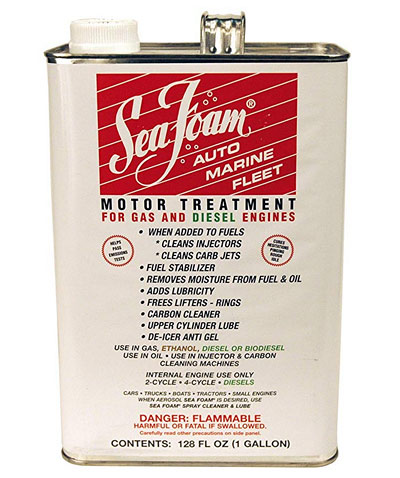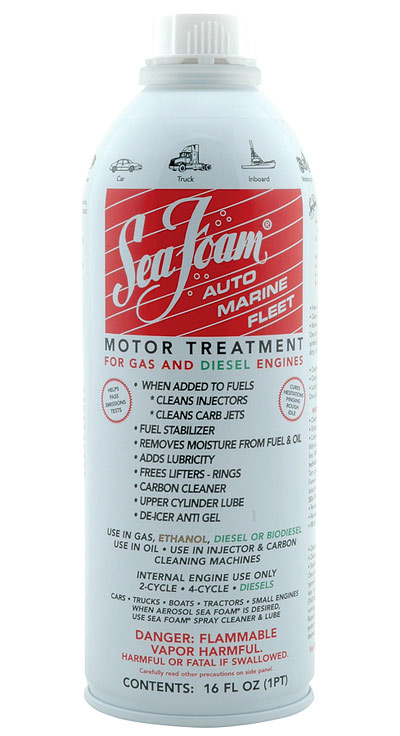Sea Foam Motor Treatment For Combustion Chamber, Injectors, Carburetor

Sea Foam Motor Treatment might be a must-have all-purpose item for the household. I’ve been using the stuff for years, says ‘Bogan’ on Modern Survival Blog.
I’m re-publishing Bogan’s guest article because I thought of it yesterday when I pulled out the old Toro lawnmower to cut some grass where the rider mowers won’t fit. The old Toro had been kinda hard-starting. A number of pulls to get ‘er going… Enough procrastination – time to work some magic on that combustion chamber / carburetor with Seafoam motor treatment! So I dumped some in the fuel tank, mowed the grass that I needed to mow, and just magic – starts on the first pull now!
Guest article by Bogan
In cars, trucks, outboard motors, lawn equipment, logging equipment and more.
I buy it by the gallon. It’s that ubiquitous.
What Is Sea Foam Motor Treatment?
What is Sea Foam? According to their website, Sea Foam was initially developed for the outboard motor and marine market back in the 1930s by Fred Fandrei.
He was a District Manager for the Sinclair Refining Company (remember the dinosaur signs?) who owned an outboard motor that would gum up from the gas and oil mixture between uses.
Necessity being the mother of invention he leveraged his knowledge of fuel to invent a product that will stop the gas/oil mixture from becoming stale. And so an empire was born.
Fast forward 80 plus years and the product is still going strong.
Sea Foam as a Combustion Chamber Cleaner
Sea Foam as a Fuel Injector or Carburetor Cleaner
Their website shows all kinds of uses for it.
I’ll share what I use it for which is a much shorter list:
To clean fuel systems including gasoline and diesel, and lubrication systems – particularly vehicle oil. It cleans, flushes and stabilizes.
How much Sea Foam do you add to fuel?
For Regular maintenance:
Add 1 ounce per gallon of fuel.
For cleaning:
Use 2 or more ounces per gallon – the more you add to fuel, the better it cleans.
For Injector cleaning machines:
Use 50/50 mixed with gas.
– For car and truck engines, I add some to the fuel tank every time I do an oil change. This keeps injectors clean and the vehicle running smoothly.
– Works in crankcase oil to liquefy harmful residues deposits: For my diesel truck I fill up the new fuel filter with Sea Foam before swapping it out for the old one. Some smoke may billow out for a few miles but it’s doing a great job cleaning the carbon deposits. This happens about annually.
– 50-100 miles prior to changing the oil in a car or truck, I’ll add a few ounces into the engine oil. When you go to drain the oil, it frees up lots of gunk and crud which comes out with the oil. The cleaner the better, right?
– For marine and lawn equipment I run it in the fuel mix: it both stabilizes and cleans.
– For stored fuel it stabilizes: gas or diesel fuels, up to 2 years. It’s safe for all gasoline & diesel engines.
– 2-stroke equipment that has been sitting a bit too long and is gummed up, I’ll tilt it so the throat of the carburetor is facing upward then flood it out with Sea Foam. Let set for a few minutes, then start cranking. May have to repeat this process a couple times, but once the engine revs up and the smoke dies down you’re GTG!
How Does Sea Foam Work?
From the manufacturer:
1. Sea Foam Motor Treatment works to dissolve and clean fuel deposits and sticky residues from gas and diesel injectors, carburetors, and combustion chambers.
2. Sea Foam helps to stabilize stored fuel for up to two years by resisting evaporation, preserving ignition vapors, and preventing the formation of gum and varnish.
3. it provides high-temp upper cylinder lubricity and helps to protect the entire fuel system from dry out, wear and corrosion
4. Sea Foam only contains petroleum-based ingredients. It does NOT have harsh detergent or abrasive chemicals that can harm your engine. The more you add to fuel, the better it cleans.
I’ve tried StaBil, PRI-D and G, Lucas, and others, and am confident they all work, but the Sea Foam is the one-does-all IMO. And now that I’ve scrolled through a few pages of their website have even more ideas. The stuff just works!
Anyway, Ken links it on Amazon (at no additional cost to you),
Or you can find it at big box and auto parts stores.
(I’m not affiliated, own no stock, etc. Its just a good product and I’m a retail consumer. -Bogan)
For more information, you might visit their website,
SeaFoamSales.com
[ Read: Run Your Portable Generator Several Times a Year – Here’s Why ]


